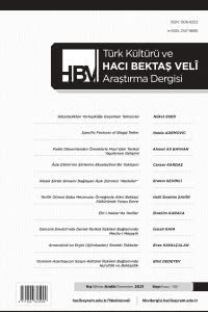Blagaj Tekkesi’nin Belirli Özellikleri
Tekke (tekke, khanqah), dervişlerin (Sufilerin) toplandığı, ikamet ettiği ve dini ayinler gerçekleştirdiği İslami bir kurumdur. Tekke kelimesi Farsça kökenlidir. Bosna-Hersek’te tekkeler, 15. yüzyılda İslam’ın gelişiyle ortaya çıktı. Bununla birlikte, Isa-beg Ishaković tarafından 1461’de Saraybosna’da inşa edilen Bentbaša’daki Mevlevi tekkesi gibi bazıları Osmanlıların gelişinden önce inşa edilmiştir. Tekkeler genellikle ilk inşa edilen ve şehrin girişinde bulunan yapılardır. Genellikle dervişler, çoğunlukla da şeyhler tarafından yaptırılırmışlardır. Dini amaçlara ek olarak, ara sıra seyahat edenler için bir dinlenme yeri veya konaklama yeri olarak da hizmet ettiler. Bosna Hersek genelinde batıdan doğuya, kuzeyden güneye çok sayıda tekke bulunmaktadır. Bosna-Hersek’teki en ünlü tekkelerden bazıları Blagaj’daki Buna, Hacı Sinanova tekkesi, Saraybosna’daki Nadmlini tekkesi, Kaćuni’deki tekke, Jajce’deki tekke, Živčići’deki tekke ve diğerleridir. Bosna Hersek’in en önemli tekkelerinden biri de Buna’nın kaynağındaki Blagaj kasabasındaki tekkedir. Bu çalışma, bu tekke ve bu külliyedeki diğer yapıların en önemli ve karakteristik özelliklerini ele almayı amaçlamaktadır
Anahtar Kelimeler:
Tekke, Musafirhana binası, Türbe, Blagaj, Bosna Hersek
Specific Features of Blagaj Tekke
Tekija (tekke, khanqah) is an Islamic institution where dervishes (Sufis) gather, reside, and perform religious rites. The word tekke is of Persian origin. In Bosnia and Herzegovina, tekkes appeared with the advent of Islam in the 15th century. However, some were built before the arrival of the Ottomans, such as the Mevlevi tekke in Bentbaša built by Isa-beg Ishaković in 1461 in Sarajevo. Tekkes were usually the first buildings that were constructed and located at the entrance of the city. Usually, they were built by dervishes, most often sheiks. Besides religious purposes, they also served as resting places or lodgings for casual travelers. There are numerous tekkes throughout Bosnia and Herzegovina from west to east, from north to south. Some of the most famous tekkes in Bosnia and Herzegovina are the tekke at the Buna spring in Blagaj, the Hadži Sinan’s tekke, Nadmlini tekke in Sarajevo, tekke in Kaćuni, tekke in Jajce, tekke in Živčići, and others. Among these, one of the most distinguished tekke in Bosnia and Herzegovina is the one at the Buna spring in the city of Blagaj. The paper aims to elaborate on the most important characteristics and main features of this tekke and other structures within this complex.
Keywords:
Tekke, Musafirhana building, Türbe, Blagaj, Bosnia and Herzegovina.,
___
- Alija, Bejtić. (1983). Spomenik Osmanlijska Arhitekture u Bosni i Hercegovini, Prilozi za orijentalnu filologiju 3-4:229-297, Sarajevo.
- Ayverdi E. Hakki. (1981). Avrupa’da Osmanlı Mimari Eserleri-Yugoslavya (3.cilt, 3.kitap), İstanbul Fetih Cemiyeti
- Čelebi, Evlija. (1996). Putopis-odlomci o jugoslovenskim zemljama. Sarajevo: Sarajevo publishing.
- Čelić, Džemal. (1953). “Musafirhana Blagajske Tekije”, Naše starine 1, 189-193.
- Decision (2004), Commission to Preserve National Monuments of Bosnia and Herzegovina “Tekke in Blagaj on the Buna Spring, the natural and architectural ensemble of Blagaj”. Official Gazette BIH, no. 37.04, http://old.kons.gov.ba/main.php?id_struct=6&lang=1&action=view&id=1867, accessed 02.05.2021.
- Grube, Ernst J.; Dickie, James; Grabar, Oleg; Sims, Eleanor, Lewcock, Ronald; Jones, Dalu; Petherbridge, Guy T. (2011). Architecture of the Islamic world. Thames & Hudson, Edited by George Michell.
- Hadžijahić, Muhamed. (2010). “Tri etape u historijatu tekije na vrelu Bune u Blagaju (bogumilska, bektašijska i halvetijska)”, in Proceedings: Dani mevluda i zikra 2010, Medžlis iz Mostar, Mostar, 169-172.
- Hadžimuhamedović, Amra. (2002). “Prostorne osobenosti tekija u Bosni i Hercegovini”, http://h.etf.unsa.ba/tekija/bos/download/AmraHadzimuhamedovic-7faktora.pdf, accessed 15.07.2021.
- Hasandedić, Hivzija. (1988). “Nekoliko novih podataka iz prošlosti tekije u Blagaju kod Mostara”, Glasnik VIS-a 2, Sarajevo, 207-209.
- Keddie, Nikki R. (1972). Scholars, Saints, and Sufis. Los Angeles: University of California Press.
- Mujezinović, Nermina. (2000). “Blagaj kod Mostara”, Hercegovina 11-12, 1-13.
- Pašić, Amir (2009b) “Historijska rekonstrukcija muzafirhane Tekije u Blagaju”, Script made for the internal needs of the Majlis of the Islamic Community of Mostar and the Mufti of Mostar, Archive of Majlis of the Islamic Community of Mostar, 1-16.
- Pašić, Amir. (2009a). “Historijska rekonstrukcija ansambla tekije u Blagaju”, in Proceedings of the scientific meeting “Natural-architectural ensemble of Blagajska tekke and Buna spring” Mostar 10.05.2007-Mostar: Medžlis Islamske zajednice, 164-167.
- UNESCO. (2009). “The natural and architectural ensemble of Blagaj”, UNESCO World Heritage Centre. http://whc.unesco.org/en/tentativelists/5280/, accessed 02.05.2021.
- Vakufsko povjerenstvo Mostar 346/33, 1953-1958.
- ISSN: 1306-8253
- Yayın Aralığı: Yılda 4 Sayı
- Başlangıç: 1994
- Yayıncı: Ankara Hacı Bayram Veli Üniversitesi Türk Kültürü Açısından Hacı Bektaş-ı Veli Araştırmaları Uygulama ve Araştırma Merkezi
Sayıdaki Diğer Makaleler
BİR HALK RESSAMININ İZİNDE SATILMIŞ KÖYÜ CAMİİ DUVAR RESİMLERİ
TEVFİK OTMAN BABA MECMUASI ÖRNEĞİNDE ALEVİ BEKTAŞİ KÜLTÜRÜNDE YUNUS EMRE
KLASİK ŞİİRDE SİNESİNİ DAĞLAYAN ÂŞIK ZÜMRESİ “ABDALLAR”
HİL’AT-NÂME-İ HASAN-HÜSEYİN: PEYGAMBER TORUNLARININ KATLİNE DAİR BİR KEHANET ANLATISI
TARİKAT KÜLTÜRÜNDEN BİR KESİT: OSMANLI MİMARİ SÜSLEMESİNDE KARPUZ VE KARPUZ-BIÇAK TASVİRLERİ
DOĞU KARADENİZ CAMİLERİNDEKİ TASAVVUFİ TASVİRLER
OSMANLI DEVLETİNDE DEVLET-TARİKAT İLİŞKİLERİ BAĞLAMINDA MECLİS-İ MEŞAYİH
ARNAVUTLUK’UN ERGİRİ (GJİROKASTER) İLİNDEKİ TEKKELER
İNANÇ-MEKÂN İLİŞKİSİ BAĞLAMINDA CEMEVLERİNİN KORUNMASI: MALATYA ARAPGİR ONAR KÖYÜ CEMEVLERİ
